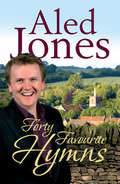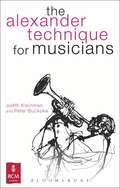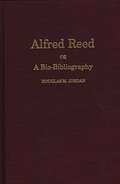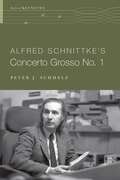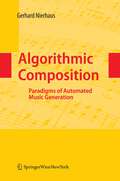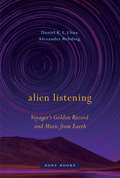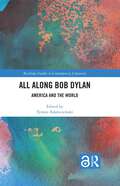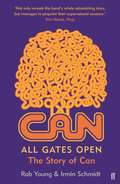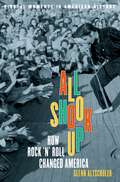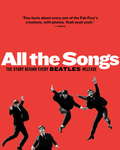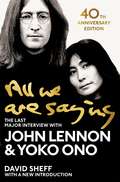- Table View
- List View
Aled Jones' Favourite Christmas Carols
by Aled JonesThe perfect gift for Christmas, this book includes all your favourite carols brought vividly to life with Aled's personal reminiscences of singing them and thoughts on why each is so special. Accompanied by the history of the words and music, and for nine of the carols the sheet music for piano.Includes: 'Away in a Manger', 'Come All Ye Faithful', 'In the Bleak Midwinter', 'Angel Gabriel', 'O Come Emmanuel', 'Hark the Herald Angels', 'Silent Night', 'O Little Town Of Bethlehem', 'Little Drummer Boy', 'Joy to the World', 'Deck the Halls', 'Ding Dong Merrily', 'God Rest Ye Merry Gentlemen', 'Once In Royal David's City', 'The First Noel', 'While Shepherds Watched', 'Coventry Carol', 'Calypso Carol', 'Still, Still, Still', 'Do You Hear What I Hear?', 'Good King Wenceslas', 'Mary's Boy Child', 'Holy Night', 'The Twelve Days Of Christmas', 'The Little Road To Bethlehem', 'Mary Had a Baby', 'Little Donkey'.
Aled Jones' Forty Favourite Hymns
by Aled JonesHere is Aled Jones' selection of his favourite hymns, ranked from number one through to forty. From Guide Me, O Thou Great Redeemer to Dear Lord and Father of Mankind and Shine Jesus Shine, each is accompanied by the history of its words and music. Aled brings the hymns vividly to life with his own reminiscences of performing them and thoughts on why each is such a winner, and he garners the experiences of today's great singers and composers. Written with grace, humour and real personal insight, this is a collection that will be enjoyed across the land.
Alesha Dixon: Her Story - The Unauthorized Biography
by Anna TrippAlesha Dixon has not followed the easy path to fame. Suffering heartbreak, rejection and struggles that would test any of us, her strength of will and character were pushed to the limit. After early fame with R&B girl band Mis-Teeq, Alesha was dropped from her record label and experienced the breakdown of her marriage. However, her inner strength and determination to succeed were demonstrated in her victory as 2007 winner of Strictly Come Dancing. Since then, she has never looked back, becoming a platinum-selling solo artist, Strictly judge and household name. This is Alesha's story: of how she scaled and conquered the heights, as well as the crevasses, of celebrity to become one of Britain's best-loved celebrities.
The Alexander Technique for Musicians
by Judith Kleinman Peter BuckokeThe Alexander Technique for Musicians is a unique guide for all musicians, providing a practical, informative approach to being a successful and comfortable performer. Perfect as an introduction to the Alexander Technique, or to supplement the reader's lessons, the book looks at daily and last-minute practice, breathing, performance and performance anxiety, teacher–pupil relationships, ensemble skills, and the application of the Alexander Technique to instrumental and vocal work. Complete with diagrams and photographs to aid the learning process, as well as step-by-step procedures and diary entries written by participating students, The Alexander Technique for Musicians gives tried-and-tested advice, drawn from the authors' twenty-plus years of experience working with musicians, providing an essential handbook for musicians seeking the most from themselves and their art.
The Alexander Technique for Musicians
by Judith Kleinman Peter BuckokeThe Alexander Technique for Musicians is a unique guide for all musicians, providing a practical, informative approach to being a successful and comfortable performer. Perfect as an introduction to the Alexander Technique, or to supplement the reader's lessons, the book looks at daily and last-minute practice, breathing, performance and performance anxiety, teacher–pupil relationships, ensemble skills, and the application of the Alexander Technique to instrumental and vocal work. Complete with diagrams and photographs to aid the learning process, as well as step-by-step procedures and diary entries written by participating students, The Alexander Technique for Musicians gives tried-and-tested advice, drawn from the authors' twenty-plus years of experience working with musicians, providing an essential handbook for musicians seeking the most from themselves and their art.
Alfred Reed: A Bio-Bibliography (Bio-Bibliographies in Music)
by Douglas M. JordanThis reference guide to the life and work of the prolific American wind band composer, Alfred Reed, includes a brief biography followed by detailed bibliography and discography sections. The biography traces Reed's life and those experiences that helped to shape his music and philosophies. Attention is given to Reed's popularity with and influences upon bands throughout the world and especially in Japan. A complete listing of Reed's more than 250 works and premiers are categorized by genre. The extensive discography section cites more than 400 recordings, and the bibliography section includes the many writings by and about Reed.This unique reference will appeal to music scholars and band directors with an interest in Alfred Reed and in wind band music. As a useful research tool, each section of the volume is cross-referenced. Additionally, two appendices list Reed's compositions, one alphabetically and the other chronologically.
ALFRED SCHNIT CONCER GROSSO NO. 1 OKS C (The Oxford Keynotes Series)
by Peter J. SchmelzConcerto Grosso no. 1 is one of Alfred Schnittke's best-known and most compelling works, sounding the surface of late Soviet life while resonating with contemporary compositional currents around the world such as postmodernism. It marked a decisive point in Schnittke's development of the approach he called polystylism, which aimed to contain in a single composition the wide range of contemporary musical styles, including "jazz, pop, rock, or serial music." Thanks to it and his other similar compositions, Schnittke became one of the most-performed and most-recorded living composers at the end of the twentieth century. Peter J. Schmelz's Alfred Schnittke's Concerto Grosso no. 1 represents the first accessible and comprehensive study of this composition. The novel structure of the book engages with the piece conceptually, historically, musically, and phenomenologically, with the six movements of the composition framing the six chapters. Augmenting and complicating the insights of existing English, Russian, and German publications on the Concerto Grosso no. 1, the book adds new information from underused primary sources, including Schnittke's unpublished correspondence and his many published interviews. It engages further with his sketches for the piece, and with contemporary Soviet musical criticism, resulting in a more objective, historical account of this rich, multifaceted composition, its influences, and its impact on music making in the USSR and worldwide.
Alfred Schnittke's Concerto Grosso no. 1 (The Oxford Keynotes Series)
by Peter J. SchmelzConcerto Grosso no. 1 is one of Alfred Schnittke's best-known and most compelling works, sounding the surface of late Soviet life while resonating with contemporary compositional currents around the world such as postmodernism. It marked a decisive point in Schnittke's development of the approach he called polystylism, which aimed to contain in a single composition the wide range of contemporary musical styles, including "jazz, pop, rock, or serial music." Thanks to it and his other similar compositions, Schnittke became one of the most-performed and most-recorded living composers at the end of the twentieth century. Peter J. Schmelz's Alfred Schnittke's Concerto Grosso no. 1 represents the first accessible and comprehensive study of this composition. The novel structure of the book engages with the piece conceptually, historically, musically, and phenomenologically, with the six movements of the composition framing the six chapters. Augmenting and complicating the insights of existing English, Russian, and German publications on the Concerto Grosso no. 1, the book adds new information from underused primary sources, including Schnittke's unpublished correspondence and his many published interviews. It engages further with his sketches for the piece, and with contemporary Soviet musical criticism, resulting in a more objective, historical account of this rich, multifaceted composition, its influences, and its impact on music making in the USSR and worldwide.
Algorithmic Composition: Paradigms of Automated Music Generation
by Gerhard NierhausAlgorithmic composition – composing by means of formalizable methods – has a century old tradition not only in occidental music history. This is the first book to provide a detailed overview of prominent procedures of algorithmic composition in a pragmatic way rather than by treating formalizable aspects in single works. In addition to an historic overview, each chapter presents a specific class of algorithm in a compositional context by providing a general introduction to its development and theoretical basis and describes different musical applications. Each chapter outlines the strengths, weaknesses and possible aesthetical implications resulting from the application of the treated approaches. Topics covered are: markov models, generative grammars, transition networks, chaos and self-similarity, genetic algorithms, cellular automata, neural networks and artificial intelligence are covered. The comprehensive bibliography makes this work ideal for the musician and the researcher alike.
Alien Listening: Voyager's Golden Record and Music from Earth
by Daniel K. Chua Alexander RehdingAn examination of NASA's Golden Record that offers new perspectives and theories on how music can be analyzed, listened to, and thought about—by aliens and humans alike.In 1977 NASA shot a mixtape into outer space. The Golden Record aboard the Voyager spacecrafts contained world music and sounds of Earth to represent humanity to any extraterrestrial civilizations. To date, the Golden Record is the only human-made object to have left the solar system. Alien Listening asks the big questions that the Golden Record raises: Can music live up to its reputation as the universal language in communications with the unknown? How do we fit all of human culture into a time capsule that will barrel through space for tens of thousands of years? And last but not least: Do aliens have ears?The stakes could hardly be greater. Around the extreme scenario of the Golden Record, Chua and Rehding develop a thought-provoking, philosophically heterodox, and often humorous Intergalactic Music Theory of Everything, a string theory of communication, an object-oriented ontology of sound, and a Penelopean model woven together from strands of music and media theory. The significance of this exomusicology, like that of the Golden Record, ultimately takes us back to Earth and its denizens. By confronting the vast temporal and spatial distances the Golden Record traverses, the authors take listeners out of their comfort zone and offer new perspectives in which music can be analyzed, listened to, and thought about—by aliens and humans alike.
Alien Listening: Voyager's Golden Record and Music from Earth
by Daniel K. Chua Alexander RehdingAn examination of NASA's Golden Record that offers new perspectives and theories on how music can be analyzed, listened to, and thought about—by aliens and humans alike.In 1977 NASA shot a mixtape into outer space. The Golden Record aboard the Voyager spacecrafts contained world music and sounds of Earth to represent humanity to any extraterrestrial civilizations. To date, the Golden Record is the only human-made object to have left the solar system. Alien Listening asks the big questions that the Golden Record raises: Can music live up to its reputation as the universal language in communications with the unknown? How do we fit all of human culture into a time capsule that will barrel through space for tens of thousands of years? And last but not least: Do aliens have ears?The stakes could hardly be greater. Around the extreme scenario of the Golden Record, Chua and Rehding develop a thought-provoking, philosophically heterodox, and often humorous Intergalactic Music Theory of Everything, a string theory of communication, an object-oriented ontology of sound, and a Penelopean model woven together from strands of music and media theory. The significance of this exomusicology, like that of the Golden Record, ultimately takes us back to Earth and its denizens. By confronting the vast temporal and spatial distances the Golden Record traverses, the authors take listeners out of their comfort zone and offer new perspectives in which music can be analyzed, listened to, and thought about—by aliens and humans alike.
All About Music: The Complete Ontology: Realities, Semiotics, Communication, and Embodiment (Computational Music Science)
by Guerino Mazzola Maria Mannone Yan Pang Margaret O'Brien Nathan TorunskyThis book explains music’s comprehensive ontology, its way of existence and processing, as specified in its compact characterization: music embodies meaningful communication and mediates physically between its emotional and mental layers. The book unfolds in a basic discourse in everyday language that is accessible to everybody who wants to understand what this topic is about. Musical ontology is delayed in its fundamental dimensions: its realities, its meaningful communication, and its embodied utterance from musical creators to an interested audience. The authors' approach is applicable to every musical genre and is scientific, the book is suitable for non-musicians and non-scientists alike.
All Along Bob Dylan: America and the World (Routledge Studies in Contemporary Literature)
by Tymon AdamczewskiAll Along Bob Dylan: America and the World offers an important contribution to thinking about the artist and his work. Adding European and non-English speaking contexts to the vibrant field of Dylan studies, the volume covers a wide range of topics and methodologies while dealing with the inherently complex and varied material produced or associated with the iconic artist. The chapters, organized around three broad thematic sections (Geographies, Receptions and Perspectives), address the notions of audience, performance and identity, allowing to map out the structure of feeling and authenticity, both, in the case of the artist and his audience. Taking its cue from the collapse of the so-called high-/ low culture split following from the Nobel Prize, the book explores the argument that Dylan (and all popular music) can be interpreted as literature and offers discussions in the context of literary traditions, or visual culture and music. This contributes to a nuanced and complex portrayal of the seminal cultural phenomenon called Bob Dylan.
All Along Bob Dylan: America and the World (Routledge Studies in Contemporary Literature)
by J. Roger KurtzAll Along Bob Dylan: America and the World offers an important contribution to thinking about the artist and his work. Adding European and non-English speaking contexts to the vibrant field of Dylan studies, the volume covers a wide range of topics and methodologies while dealing with the inherently complex and varied material produced or associated with the iconic artist. The chapters, organized around three broad thematic sections (Geographies, Receptions and Perspectives), address the notions of audience, performance and identity, allowing to map out the structure of feeling and authenticity, both, in the case of the artist and his audience. Taking its cue from the collapse of the so-called high-/ low culture split following from the Nobel Prize, the book explores the argument that Dylan (and all popular music) can be interpreted as literature and offers discussions in the context of literary traditions, or visual culture and music. This contributes to a nuanced and complex portrayal of the seminal cultural phenomenon called Bob Dylan.
All Gates Open: The Story of Can
by Rob Young Irmin SchmidtAll Gates Open presents the definitive story of arguably the most influential and revered avant-garde band of the late twentieth century: CAN. It consists of two books. In Book One, Rob Young gives us the full biography of a band that emerged at the vanguard of what would come to be called the Krautrock scene in late sixties Cologne. With Irmin Schmidt and Holger Czukay - two classically trained students of Stockhausen - at the heart of the band, CAN's studio and live performances burned an incendiary trail through the decade that followed: and left a legacy that is still reverberating today in hip hop, post rock, ambient, and countless other genres. Rob Young's account draws on unique interviews with all founding members of CAN, as well as their vocalists, friends and music industry associates. And he revisits the music, which is still deliriously innovative and unclassifiable more than four decades on. All Gates Open is a portrait of a group who worked with visionary intensity and belief, outside the system and inside their own inner space. Book Two, Can Kiosk, has been assembled by Irmin Schmidt, founding member and guiding spirit of the band, as a 'collage - a technique long associated with CAN's approach to recording. There is an oral history of the band drawing on interviews that Irmin made with musicians who see CAN as an influence - such as Bobby Gillespie, Geoff Barrow, Daniel Miller, and many others. There are also interviews with artists and filmmakers like Wim Wenders and John Malkovitch, where Schmidt reflects on more personal matters and his work with film. Extracts of Schmidt's notebook and diaries from 2013-14 are also reproduced as a reflection on the creative process, and the memories, dreams, and epiphanies it entails. Can Kiosk offers further perspectives on a band that have inspired several generations of musicians and filmmakers in the voices of the artists themselves. CAN were unique, and their legacy is articulated in two books in this volume with the depth, rigour, originality, and intensity associated with the band itself. It is illustrated throughout with previously unseen art, photographs, and ephemera from the band's archive.
All Of Me: My Story
by Claire RichardsClaire Richards is loved by women everywhere for her warm and genuine personality. Now she writes honestly about her life, taking us from the bullied schoolgirl who dreamed of peforming at Wembley to finding stardom with Steps. She reveals the secrets of the music industry and what it's really like to be in a band at the top of their career, from the unhealthy pressure to stay thin to the backstage rows. She describes how the stress of her affair caused her to starve herself, and explains why she and fellow bandmate H controversially resigned. Claire also opens us about why her first marriage to Steps dancer Mark didn't last, her dramatic weight gain and years of yo-yo dieting as she battled low self-esteem, and how she found happiness with second husband Reece and their two children Charlie and Daisy. And she takes us behind the scenes of the Steps reunion tour as old issues rose to the surface. Entertaining, touching and funny, this is sure to appeal to Claire's many fans.
All Shook Up: How Rock 'n' Roll Changed America (Pivotal Moments in American History)
by Glenn C. AltschulerThe birth of rock 'n roll ignited a firestorm of controversy--one critic called it "musical riots put to a switchblade beat"--but if it generated much sound and fury, what, if anything, did it signify? As Glenn Altschuler reveals in All Shook Up, the rise of rock 'n roll--and the outraged reception to it--in fact can tell us a lot about the values of the United States in the 1950s, a decade that saw a great struggle for the control of popular culture. Altschuler shows, in particular, how rock's "switchblade beat" opened up wide fissures in American society along the fault-lines of family, sexuality, and race. For instance, the birth of rock coincided with the Civil Rights movement and brought "race music" into many white homes for the first time. Elvis freely credited blacks with originating the music he sang and some of the great early rockers were African American, most notably, Little Richard and Chuck Berry. In addition, rock celebrated romance and sex, rattled the reticent by pushing sexuality into the public arena, and mocked deferred gratification and the obsession with work of men in gray flannel suits. And it delighted in the separate world of the teenager and deepened the divide between the generations, helping teenagers differentiate themselves from others. Altschuler includes vivid biographical sketches of the great rock 'n rollers, including Elvis Presley, Fats Domino, Chuck Berry, Little Richard, Jerry Lee Lewis, and Buddy Holly--plus their white-bread doppelgangers such as Pat Boone. Rock 'n roll seemed to be everywhere during the decade, exhilarating, influential, and an outrage to those Americans intent on wishing away all forms of dissent and conflict. As vibrant as the music itself, All Shook Up reveals how rock 'n roll challenged and changed American culture and laid the foundation for the social upheaval of the sixties.
All Shook Up: How Rock 'n' Roll Changed America (Pivotal Moments in American History)
by Glenn C. AltschulerThe birth of rock 'n roll ignited a firestorm of controversy--one critic called it "musical riots put to a switchblade beat"--but if it generated much sound and fury, what, if anything, did it signify? As Glenn Altschuler reveals in All Shook Up, the rise of rock 'n roll--and the outraged reception to it--in fact can tell us a lot about the values of the United States in the 1950s, a decade that saw a great struggle for the control of popular culture. Altschuler shows, in particular, how rock's "switchblade beat" opened up wide fissures in American society along the fault-lines of family, sexuality, and race. For instance, the birth of rock coincided with the Civil Rights movement and brought "race music" into many white homes for the first time. Elvis freely credited blacks with originating the music he sang and some of the great early rockers were African American, most notably, Little Richard and Chuck Berry. In addition, rock celebrated romance and sex, rattled the reticent by pushing sexuality into the public arena, and mocked deferred gratification and the obsession with work of men in gray flannel suits. And it delighted in the separate world of the teenager and deepened the divide between the generations, helping teenagers differentiate themselves from others. Altschuler includes vivid biographical sketches of the great rock 'n rollers, including Elvis Presley, Fats Domino, Chuck Berry, Little Richard, Jerry Lee Lewis, and Buddy Holly--plus their white-bread doppelgangers such as Pat Boone. Rock 'n roll seemed to be everywhere during the decade, exhilarating, influential, and an outrage to those Americans intent on wishing away all forms of dissent and conflict. As vibrant as the music itself, All Shook Up reveals how rock 'n roll challenged and changed American culture and laid the foundation for the social upheaval of the sixties.
All The Songs: The Story Behind Every Beatles Release (All The Songs)
by Philippe Margotin Jean-Michel GuesdonEvery album and every song ever released by the Beatles - from "Please Please Me" (U.S. 1963) to "The Long and Winding Road" (U.S. 1970) - is dissected, discussed, and analyzed by two music historians in this lively, fully illustrated work.All the Songs delves deep into the history and origins of the Beatles and their music. This first-of-its-kind book draws upon decades of research, as music historians Margotin and Guesdon recount the circumstances that led to the composition of every song, the recording process, and the instruments used. Here, we learn that one of John Lennon's favorite guitars was a 1958 Rickenbacker 325 Capri, which he bought for £100 in 1960 in Hamburg, Germany. We also learn that "Love Me Do," recorded in Abbey Road Studios in September 1962, took 18 takes to get right, even though it was one of the first songs John and Paul ever wrote together. And the authors reveal that when the Beatles performed "I Want to Hold Your Hand" on The Ed Sullivan Show in 1964, John's microphone wasn't turned on, so viewers heard only Paul singing. The hundreds of photographs throughout the book include rare black-and-white publicity stills, images of Beatles instruments, and engaging shots of the musicians in-studio. All the Songs is the must-have book for the any true Beatles fan.
All The Songs: The Story Behind Every Beatles Release (All the Songs)
by Philippe Margotin Jean-Michel GuesdonEvery album and every song ever released by the Beatles - from "Please Please Me" (U.S. 1963) to "The Long and Winding Road" (U.S. 1970) - is dissected, discussed, and analyzed by two music historians in this lively, fully illustrated work.All the Songs delves deep into the history and origins of the Beatles and their music. This first-of-its-kind book draws upon decades of research, as music historians Margotin and Guesdon recount the circumstances that led to the composition of every song, the recording process, and the instruments used. Here, we learn that one of John Lennon's favorite guitars was a 1958 Rickenbacker 325 Capri, which he bought for £100 in 1960 in Hamburg, Germany. We also learn that "Love Me Do," recorded in Abbey Road Studios in September 1962, took 18 takes to get right, even though it was one of the first songs John and Paul ever wrote together. And the authors reveal that when the Beatles performed "I Want to Hold Your Hand" on The Ed Sullivan Show in 1964, John's microphone wasn't turned on, so viewers heard only Paul singing. The hundreds of photographs throughout the book include rare black-and-white publicity stills, images of Beatles instruments, and engaging shots of the musicians in-studio.All the Songs is the must-have book for the any true Beatles fan.
All The Stops: The Glorious Pipe Organ And Its American Masters
by Craig WhitneyFor centuries, pipe organs stood at the summit of musical and technological achievement, admired as the most complex and intricate mechanisms the human race had yet devised. In All The Stops, New York Times journalist Craig Whitney journeys through the history of the American pipe organ and brings to life the curious characters who have devoted their lives to its music. From the mid-19th to the mid-20th century, organ music was wildly popular in America. Organ builders in New York and New England could hardly fill the huge demand for both concert hall and home organs. Master organbuilders found ingenious ways of using electricity to make them sound like orchestras. Organ players developed cult followings and bitter rivalries. One movement arose to restore to American organs the clarity and precision that baroque organs had in centuries past, while another took electronic organs to the rock concert halls, where younger listeners could be found. But while organbuilders and organists were fighting with each other, popular audiences lost interest in the organ. Today, organs are beginning to make a comeback in concert halls and churches across America. Craig Whitney brings the story to life and up to date in a humorous, engaging book about the instruments and vivid personalities that inspired his lifelong passion: the great art of the majestic pipe organ.Hear the sounds of some of the pipe organs featured in ALL THE STOPS
All The Stops: The Glorious Pipe Organ And Its American Masters
by Craig WhitneyFor centuries, pipe organs stood at the summit of musical and technological achievement, admired as the most complex and intricate mechanisms the human race had yet devised. In All The Stops, New York Times journalist Craig Whitney journeys through the history of the American pipe organ and brings to life the curious characters who have devoted their lives to its music. From the mid-19th to the mid-20th century, organ music was wildly popular in America. Organ builders in New York and New England could hardly fill the huge demand for both concert hall and home organs. Master organbuilders found ingenious ways of using electricity to make them sound like orchestras. Organ players developed cult followings and bitter rivalries. One movement arose to restore to American organs the clarity and precision that baroque organs had in centuries past, while another took electronic organs to the rock concert halls, where younger listeners could be found. But while organbuilders and organists were fighting with each other, popular audiences lost interest in the organ. Today, organs are beginning to make a comeback in concert halls and churches across America. Craig Whitney brings the story to life and up to date in a humorous, engaging book about the instruments and vivid personalities that inspired his lifelong passion: the great art of the majestic pipe organ. Hear the sounds of some of the pipe organs featured in ALL THE STOPS
All the Madmen: Barrett, Bowie, Drake, the Floyd, The Kinks, The Who and the Journey to the Dark Side of English Rock
by Clinton HeylinBy the end of 1968 The Beatles were far too busy squabbling with each other, while The Stones had simply stopped making music; English Rock was coming to an end. All the Mad Men tells the story of six stars that travelled to edge of sanity in the years following the summer of love: Pete Townshend, Ray Davies, Peter Green, Syd Barrett, Nick Drake, and David Bowie. The book charts how they made some of the most seminal rock music ever recorded: Pink Moon; Ziggy Stardust; Quadrophenia; Dark Side of the Moon; Muswell Hillbillies - and how some of them could not make it back from the brink. The extraordinary story of how English Rock went mad and found itself
»All the Things You Are« - Die materielle Kultur populärer Musik (Beiträge zur Popularmusikforschung #47)
by Ralf Von Appen Peter KloseWie wird die Musikkultur durch die konkrete materielle Beschaffenheit von alltäglichen Gegenständen und Orten geprägt? Die Beiträger*innen unterziehen Flyer für Club Nights, Totenkopf-Shirts, Fotos auf LP-Hüllen, Bierbänke in Festzelten oder Sammlungen historischer Abspielgeräte einer genauen Analyse, um kulturelle Implikationen, überraschende Sinnpotenziale und Effekte offenzulegen. Sie entwickeln dabei eine gesteigerte Sensibilität für die ästhetisch und praktisch wirksame Beschaffenheit von Bedeutungsträgern, die nur zu leicht unterschätzt werden - und machen kulturwissenschaftliche Materialitäts-Diskurse so für das Verständnis populärer Musik fruchtbar.
All We Are Saying: The Last Major Interview with John Lennon and Yoko Ono
by John Lennon Yoko Ono David SheffThe last major interview with John Lennon and Yoko Ono, conducted by New York Times bestselling author David Sheff, featuring a new introduction that reflects on the fortieth anniversary of Lennon's death.Originally published in Playboy in 1981 just after John Lennon's assassination, All We Are Saying is a rich, vivid, complete interview with Lennon and Yoko Ono, covering art, creativity, the music business, childhood beginnings, privacy, how the Beatles broke up, how Lennon and McCartney collaborated (or didn't) on songs, parenthood, money, feminism, religion, and insecurity. Of course, at the heart of the conversation is the deep romantic and spiritual bond between Lennon and Ono.Sheff's insightful questions set the tone for Lennon's responses and his presence sets the scene, as he goes through the kitchen door of Lennon and Yoko's apartment in the Dakota and observes moments at Lennon's famous white piano and the rock star's work at the stove, making them grilled cheese sandwiches. Sheff's new introduction looks at his forty-year-old interview afresh, and examines how what he learned from Lennon has resonated with him as a man and a parent. This is a knockout interview: unguarded, wide-ranging, alternately frisky and intense.

